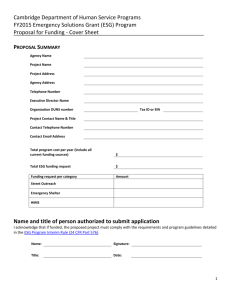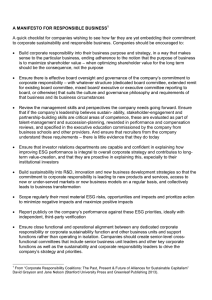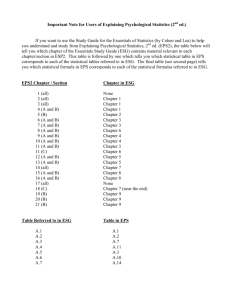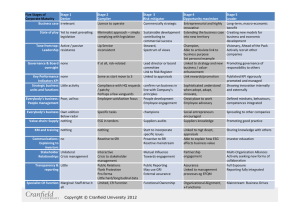Guidance for Submitting the Portions of the Consolidated
advertisement
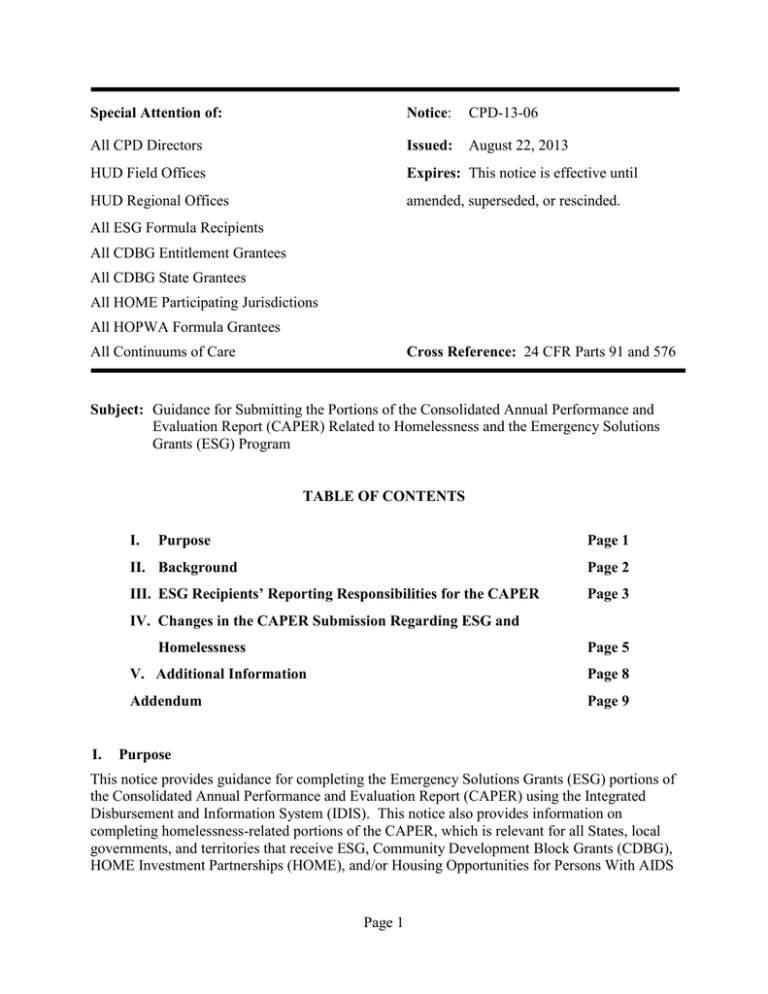
Special Attention of: Notice: CPD-13-06 All CPD Directors Issued: August 22, 2013 HUD Field Offices Expires: This notice is effective until HUD Regional Offices amended, superseded, or rescinded. All ESG Formula Recipients All CDBG Entitlement Grantees All CDBG State Grantees All HOME Participating Jurisdictions All HOPWA Formula Grantees All Continuums of Care Cross Reference: 24 CFR Parts 91 and 576 Subject: Guidance for Submitting the Portions of the Consolidated Annual Performance and Evaluation Report (CAPER) Related to Homelessness and the Emergency Solutions Grants (ESG) Program TABLE OF CONTENTS I. Purpose Page 1 II. Background Page 2 III. ESG Recipients’ Reporting Responsibilities for the CAPER Page 3 IV. Changes in the CAPER Submission Regarding ESG and Homelessness I. Page 5 V. Additional Information Page 8 Addendum Page 9 Purpose This notice provides guidance for completing the Emergency Solutions Grants (ESG) portions of the Consolidated Annual Performance and Evaluation Report (CAPER) using the Integrated Disbursement and Information System (IDIS). This notice also provides information on completing homelessness-related portions of the CAPER, which is relevant for all States, local governments, and territories that receive ESG, Community Development Block Grants (CDBG), HOME Investment Partnerships (HOME), and/or Housing Opportunities for Persons With AIDS Page 1 (HOPWA) formula funding (referred to collectively in this notice as Consolidated Plan (Con Plan) jurisdictions). II. Background On May 20, 2009, President Obama signed into law the Homeless Emergency Assistance and Rapid Transition to Housing (HEARTH) Act (Public Law 111-22, Division B). The law renames the Emergency Shelter Grants program as the Emergency Solutions Grants program. The change in the program’s name reflects the change in the program’s focus from addressing the needs of homeless people in emergency shelters to assisting people to quickly regain stability in permanent housing after experiencing a housing crisis and/or homelessness. On December 5, 2011, HUD published the ESG Program interim rule amending the ESG program regulations at 24 CFR Part 576 and related Consolidated Plan regulations at 24 CFR Part 91 (76 FR 75954) (ESG Program interim rule), which became effective on January 4, 2012. The ESG Program interim rule substantially changed the required reporting elements for the ESG program and strengthened the homelessness elements of the CAPER that apply to all Con Plan jurisdictions. The changes to the Consolidated Plan sections on homelessness were guided by the larger purposes of the HEARTH Act and the principles and priorities put forth in Opening Doors: The Federal Strategic Plan to Prevent and End Homelessness. This notice addresses the changes specifically affecting the CAPER in Section IV below. In May 2012, HUD released the eCon Planning Suite, which provides Con Plan jurisdictions a collection of new online tools for electronic submission of their Consolidated Plans, Annual Action Plans, and CAPERs in IDIS. As of November 15, 2012, Con Plan jurisdictions submitting new Consolidated Plans are required to use IDIS to submit these and all subsequent plans, including Annual Action Plans. Con Plan jurisdictions that are not required to submit a new Consolidated Plan at this time are permitted, but not required, to use IDIS to prepare and submit their Annual Action Plan in the system. For more information on using IDIS to submit the Consolidated Plan, see CPD Notice 12-009. Within 90 days of the end of its program year, a Con Plan jurisdiction is required to provide an annual performance report, known as the CAPER, to HUD that summarizes its performance for the program year. Con Plan jurisdictions that do not receive ESG funds may use IDIS to prepare and submit the entire CAPER only after they have an approved Annual Action Plan in IDIS. However, Con Plan jurisdictions that receive ESG funds (ESG recipients) are required to use the ESGonly portion of the CAPER template in IDIS beginning October 1, 2012, regardless of whether an approved Consolidated or Annual Action Plan has been submitted in IDIS (see Section III). The ESG-only portion of the CAPER template in IDIS replaces the beneficiary data screens in IDIS as well as sections of the Consolidated Plan Management Process (CPMP) tool and corresponding State/local jurisdiction tables that capture Emergency Shelter Grants data. These have not been updated to reflect the conforming amendments to 24 CFR Part 91; therefore, ESG recipients must not use the CPMP tool or the State/local jurisdiction tables to Page 2 complete the ESG-only portion of the CAPER in IDIS. ESG recipients that have Emergency Shelter Grants program performance data to report must incorporate that data into the ESG-only CAPER screens in IDIS where applicable. HUD is requiring ESG recipients to ensure that they are meeting all new CAPER requirements, which this notice addresses, in their complete CAPER submission. The CAPER is now the primary mechanism for ESG accomplishment reporting since IDIS does not contain beneficiary or accomplishment data screens for ESG (other than those screens contained in the CAPER submission template). However, the May 2012 release of the eCon Planning Suite includes only limited screens for the ESG-only portion of the CAPER. HUD considers this to be a “transition” CAPER in IDIS and plans to release more complete ESG-only CAPER screens at a later date. HUD’s goal is to design ESG-only CAPER screens that reflect recipient-level data similar to what is reported in the Annual Performance Reports (APRs) by Continuum of Care (CoC) Program recipients. The current ESG-only CAPER template screens are the first step for HUD to gather comprehensive, nationwide data on the uses of ESG funds in this new format. Provisions at 24 CFR 576.400(f) require ESG recipients and subrecipients to enter all data on clients served and activities assisted with ESG funds, including any matching funds, in the applicable community-wide Homeless Management Information Systems (HMIS) (or a comparable database, as required) in the area where those clients and activities are located. Therefore, HUD expects that all communities are working towards using HMIS to complete the majority of the information required in the CAPER. Recipients are required to report data in the CAPER in accordance with 24 CFR 576.500(aa). In the future, updated CAPER template screens will reflect new HMIS Data Standards and further align the ESG-only portion of the CAPER with the APR for CoC Program recipients. ESG recipients must often work with their local CoCs, and the HMIS Lead in the CoC, to obtain data required for completion of the CAPER. The interim rules for ESG and the CoC Program require increased collaboration between ESG recipients and CoCs. In fact, the CoC Program interim rule requires each CoC to provide information required to complete the Consolidated Plan (24 CFR 578.7). HUD expects that CoCs and ESG recipients will work together to ensure that the CAPER is accurate and complete. III. ESG Recipients’ Reporting Responsibilities for the CAPER A. Recipient and Subrecipient Roles ESG recipients that do not have an approved Annual Action Plan in IDIS are required to complete the ESG-only portion of the CAPER in IDIS and submit it, along with required supplemental information identified in the Addendum and the rest of the Con Plan jurisdiction’s CAPER, to the CPD field office in hard copy form. ESG recipients that have an approved Annual Action Plan in IDIS must submit their entire CAPER, including the required supplemental information (see the Addendum), in IDIS. ESG subrecipients are prohibited from submitting a CAPER. Page 3 1. Recipients are responsible for ensuring that their subrecipients provide them with HMIS data. Currently, there are two ways that subrecipients can submit such data: a. The ESG-CAPER Subrecipient Report* can be programmed into the HMIS system to generate an HMIS report for the CAPER. The ESG CAPER Reporting HMIS Programming Instructions provide HMIS vendors and HMIS Leads with HUD’s requirements for generating the ESG portion of the CAPER, limited to section “CR-65 ESG Persons Assisted.” b. The CAPER Generation Tool* can be used for HMIS systems that are not programmed to create a report specifically for the CAPER. The tool is available at: https://www.onecpd.info/resource/3134/esg-caper-generation-tool/ *Note: Recipients may also use these tools, particularly those that do not have subrecipients and are carrying out ESG activities themselves. 2. Subrecipients should contact their ESG recipients with any questions about how they should participate in data collection and reporting for the ESG program. In accordance with 24 CFR 576.400(f), recipients must ensure that subrecipients are: a. Using the local CoC’s HMIS (or comparable database, as required); and b. Collecting data on the Universal, Program Descriptor, and Program-Specific Data Elements.* *Note: ESG recipients are required to provide data on the subpopulations served with ESG funds in the “Special Populations Served” table on screen CR-65. Due to this reporting requirement, recipients are advised to use HMIS to collect data on Program-Specific Data Elements relevant to the ESG-only portion of the CAPER. B. HMIS Data Standards In April 2013, HUD published draft HMIS Data Standards. Once the data standards are finalized, recipients/subrecipients will be required to use the new standards. ESG recipients should follow the Final HMIS Data Standards Notice, published March 10, 2010, until the HMIS Data Standards are final. C. Data Collection Recognizing that not all ESG providers were contributing data to a CoC’s HMIS prior to the effective date of the ESG Program interim rule, HUD is not currently requiring that HMISs be programmed to generate a report for the ESG-only portion of this transition CAPER. However, ESG recipients should use data from the HMIS to input as much data in the ESG-only CAPER template screens as is practical and reliable. Recipients should use other data sources, such as internal financial reporting system(s), to obtain data not collected in HMIS or IDIS (i.e., financial/expenditure screens) to report the required information. Page 4 ESG recipients are responsible for aggregating and reporting data from their subrecipients in order to complete the ESG-only portion of the CAPER. HUD developed the ESG CAPER Aggregation Tool to help recipients compile data from multiple subrecipients. The tool is available at https://www.onecpd.info/resource/3133/esg-caperaggregation-tool/. IV. Changes in the CAPER Submission Regarding ESG and Homelessness A. Changes to the ESG-only CAPER Requirements For ESG recipients, the revised regulations at 24 CFR 91.520(g) now require that the ESG-only portion of the CAPER includes the: 1. number of persons assisted; 2. types of assistance provided; and 3. project or program outcomes data measured under the performance standards developed in consultation with the CoC(s) as required under 24 CFR 91.220(l)(4), 91.320(k)(3) and 576.400(a). The ESG-only CAPER screens in IDIS represent only a portion of the CAPER that Con Plan jurisdictions must submit to HUD annually. The CAPER also includes screens that apply to the Con Plan jurisdiction as a whole in addition to the program-specific CAPER reporting requirements for each formula program (i.e., CDBG, HOME, and HOPWA grants). Con Plan jurisdictions may prepare the portions of the CAPER for CDBG, HOME, and/or HOPWA in IDIS only after they have an approved Annual Action Plan in IDIS. However, ESG recipients are required to use the IDIS screens to complete the ESG-only portion of the CAPER, regardless of whether there is an approved Consolidated or Annual Action Plan in IDIS. The ESG-only CAPER template screens in IDIS were developed to capture the information required by the revised regulations at 24 CFR 91.520(g). However, ESG recipients should be aware that some data required for the ESG program are not currently included in the template screens, as noted in the Addendum. See Section IV.B.2 below for guidance on how to submit the additional information. B. Required Elements of the ESG-only Section of the CAPER 1. ESG-only Template Screens: ESG recipients submitting their CAPER are required to complete the following CAPER template screens in IDIS. Detailed information on each screen of the ESG-only portion of the CAPER template is provided in “The eCon Planning Suite: A Desk Guide for Using IDIS to Prepare the Consolidated Plan, Annual Action Plan, and CAPER/PER” and the Addendum to this notice. a. CR-60 Subrecipient Information b. CR-65 ESG Persons Assisted c. CR-70 ESG Assistance Provided Page 5 d. CR-75 ESG Expenditures Reminder: The CAPER template includes screens that collect the recipient’s expenditures. ESG recipients must use their own financial systems to complete these screens since neither HMIS nor IDIS collects financial data in the same format. 2. Required ESG Supplemental Information As noted above, not all required data for ESG have been included in the CAPER template screens. The Addendum lists those items that were unintentionally omitted as well as corrections that will be made to the ESG portions of the CAPER in future IDIS releases and guidance. The following are instructions for submitting the supplemental information for ESG: a. ESG recipients with an approved Annual Action Plan in IDIS ESG recipients with an approved Annual Action Plan in IDIS are required to submit their entire CAPER in IDIS. These recipients must ensure that they include the required ESG supplemental information listed in the Addendum by adding a text box to each of the applicable ESG-only CAPER template screens. b. ESG recipients without an approved Annual Action Plan in IDIS must: (1) input information into the ESG-only section of the CAPER template in IDIS, but do not “submit” the report; (2) ensure that the required ESG supplemental information is included, either by adding a text box to each of the applicable ESG-only CAPER template screens or completing the information in a separate document; (3) combine the paper copy of the ESG section with the other applicable sections of the CAPER; and (4) submit the complete CAPER to their local HUD field office in accordance with their regular submission process. Note: The ESG-only CAPER template screens in IDIS are not the only portions of the CAPER that affect ESG, because ESG recipients must provide ESGspecific information for the sections of the CAPER that apply to all formula programs (see section C below). The general section of the CAPER (see §91.520(a)), which encompasses all of the jurisdiction’s formula programs and pertains to the jurisdiction’s overall progress in carrying out its strategic and action plans, requires ESG-specific data. Another CAPER requirement applicable to all formula programs, including ESG, is §91.520(i). This requires the jurisdiction to compare the proposed versus actual outcomes for each outcome Page 6 measure submitted in the Consolidated Plan and to explain, if applicable, why progress was not made toward meeting those goals and objectives. C. Changes to CAPER Requirements Applicable to All Formula Programs Although not currently reflected in the CPMP tool or corresponding State/local jurisdiction forms, the new information on homelessness required by 24 CFR 91.520(b) and (c), as amended by the ESG Program interim rule, must be provided by all Con Plan jurisdictions, regardless of whether they receive ESG funding. These sections of the CAPER must reflect the results of all of the jurisdiction’s programs covered by the Consolidated Plan in providing affordable housing and in making progress towards reducing and ending homelessness. See the Addendum for information about the sections of the CPMP tool that recipients must no longer use for CAPER reporting. 1. Affordable Housing (§91.520(b)) All Con Plan jurisdictions, regardless of whether they receive ESG funding, must report on the jurisdiction’s progress in meeting its specific objective of providing affordable housing, including the number and types of families served. As a result of the ESG Program interim rule, this part of the CAPER must now include the number of homeless persons served, in addition to the numbers of extremely low-, low-, moderate-, and middle-income persons served. ESG recipients should only include units assisted with ESG-funded rental assistance in this measure if they are certain that those units meet the definition of “affordable housing” in the HOME regulations at 24 CFR 92.252 for rental housing. 2. Homelessness (§91.520(c)) Following changes made by the ESG Program interim rule, all jurisdictions, regardless of whether they receive ESG funding, must now include a narrative evaluation of their progress in meeting their specific objectives for reducing and ending homelessness through: a. outreach to homeless persons (especially unsheltered persons) and assessing their individual needs; b. addressing the emergency shelter and transitional housing needs of homeless persons; c. helping homeless persons (especially chronically homeless individuals and families, families with children, veterans and their families, and unaccompanied youth) make the transition to permanent housing and independent living, including shortening the period of time that individuals and families experience homelessness, facilitating access for homeless individuals and families to affordable housing units, and preventing individuals and families who were recently homeless from becoming homeless again; and d. helping low-income individuals and families to avoid becoming homeless, especially extremely low-income individuals and families and those who are: Page 7 (1) likely to become homeless after being discharged from publicly funded institutions and systems of care (such as health-care facilities, mental health facilities, foster care and other youth facilities, and corrections programs and institutions); (2) receiving assistance from public or private agencies that address housing, health, social services, employment, education, or youth needs. V. Additional Information ESG recipients should contact their local CPD field office with any questions or concerns about submitting the CAPER. Questions regarding the ESG elements of the transitional CAPER template may also be submitted to the OneCPD Resource Exchange Ask A Question portal. Screen-by-screen instructions are available in “The eCon Planning Suite: A Desk Guide for Using IDIS to Prepare the Consolidated Plan, Annual Action Plan, and CAPER/PER.” Page 8 Addendum A. Screen CR-60 (see pages 213-215 of “The eCon Planning Suite: A Desk Guide for Using IDIS to Prepare the Consolidated Plan, Annual Action Plan, and CAPER/PER” (Desk Guide): 1. Clarification: The Desk Guide includes a screen shot of the Recipient Information table showing entries for “Banking Flag,” “Block Access Flag” and “Entitlement Flag,” which are not included in the ESG-only CAPER template. The Desk Guide will be corrected to reflect this. 2. Clarification: The Desk Guide includes a description of the pull-down menu for the recipient’s “Organization Type” on the Recipient Information Table erroneously. The ESG-only CAPER template does not require recipients to enter their “Organization Type.” The Desk Guide will be corrected to reflect this. 3. Clarification: The Desk Guide incorrectly describes the “subrecipient or contractor name” in Table 3A, “Subrecipient Form” as being “read-only,” meaning the user cannot enter the name of the subrecipient or contractor. The recipient does, however, have the ability to enter the data in this field in the ESG-only CAPER template. The Desk Guide will be corrected to reflect this. B. Screen CR-65 (see pages 216-217 of the Desk Guide): 1. Required ESG Supplemental Information: In the Household Information table, the street outreach component was inadvertently omitted. Although not included in the CAPER template screens in IDIS, this information is still required. a. ESG recipients without an approved Annual Action Plan in IDIS can provide the supplemental information by adding a text box to the ESG-only CAPER template screens or by presenting the information as a separate document. In either case, ESG recipients must include the supplemental data as part of the paper copy of the CAPER submitted to their local HUD field office. b. ESG recipients with an approved Annual Action Plan in IDIS, that must submit their entire CAPER in IDIS, must provide the supplemental information by adding a text box to the ESG-only CAPER template screens. 2. Clarification: The Gender Information table includes the term “transgendered.” The term will be corrected to “transgender” in a future IDIS release. 3. Clarification: ESG recipients that have collected gender information under the category “Other” in HMIS are instructed to report this data under the “Unknown” category in the Gender Information table. Page 9 4. Clarification: HUD is aware that many ESG recipients are not yet able to collect the data required to complete the Special Populations Served table. Recipients are encouraged to fill out this table to the extent that the data is available and reliable. C. Screen CR-75 (see page 220-222 of the Desk Guide) 1. Clarification: Table 11b in ConPlan Desk Guide (page 220) incorrectly shows the category for the Emergency Shelter Grants program as “Expenditures for Homelessness Prevention under Emergency Shelter Grants Program.” This is a typographical error that must be corrected in a future release of the guide. In IDIS, the category is correctly titled “Expenditures for Homeless Assistance under Emergency Shelter Grants Program.” Homeless assistance is not a rapid re-housing activity, but the category is included in Table 11b to account for Emergency Shelter Grants Program funds expended for emergency shelter renovation/rehabilitation, operations, and essential services during the reporting period for the first allocation of FY 2011 and beyond. Users should not enter data in the columns for FY 2010 and earlier years for this row because these expenditures are accounted for in Table 11c. The columns in Table 11c for FY 2011 and later years capture expenditure information for the Emergency Solutions Grants program funds. 2. Clarification: The last row in Table 11b is incorrectly labeled as “Subtotal Homelessness Prevention” in IDIS and in the ConPlan Desk Guide. This category will be corrected in a future release to read: “Subtotal Rapid Re-Housing.” D. Project or Program Outcomes Data Required ESG Supplemental Information: Recipients are required to report their project or program outcomes data measured under the performance standards developed in consultation with the CoC(s). Although not included in the CAPER template screens in IDIS, this information is still required. 1. ESG recipients without an approved Annual Action Plan in IDIS can provide the supplemental information by adding a text box to the ESG-only CAPER template screens or by presenting the information as a separate document. In either case, ESG recipients must include the supplemental data as part of the paper copy of the CAPER submitted to their local HUD field office. 2. ESG recipients with an approved Annual Action Plan in IDIS, must submit their entire CAPER in IDIS, and must provide the supplemental information by adding a text box to the ESG-only CAPER template screens. E. Racial and Ethnic Data Required ESG Supplemental Information: To the extent that this information is available, recipients are required to report on the racial and ethnic status of families assisted by ESG. Racial and ethnic data are captured in screen CR-10 for the ESG, CDBG, HOME, and HOPWA programs. Page 10 1. Recipients with an approved Annual Action Plan in IDIS, that are submitting their entire CAPER in IDIS, can report this data directly on screen CR-10. 2. Since this information is not captured on the ESG-only CAPER template screens in IDIS, recipients that are using IDIS strictly for the ESG-only CAPER in IDIS must report the applicable data by adding a text box to the ESG-only CAPER template screens or by presenting the information as a separate document. In either case, ESG recipients must include the supplemental data as part of the paper copy of the CAPER submitted to their HUD field office. Recipients can use CAPER template screen CR-10 (see page 195 of the Desk Guide) as an example of how to present this data. F. CPMP Tool Guidance 1. Under the Housing section: The first paragraph of the “Specific Housing Objectives” subsection should include “homeless” as a category in addition to “extremely lowincome,” “low-income,” and moderate-income.” 2. Under the Homeless section: a. “Homeless Needs” and “Specific Homeless Prevention Elements” subsections: Do not use these subsections for CAPER reporting. Instead, follow the regulations at 91.520(c) or use the narrative prompts provided on screen CR-25 (see pages 204-205 of the Desk Guide). b. Disregard the Emergency Shelter Grants (ESG) subsection, which has been replaced by the ESG-only CAPER template screens in IDIS. Page 11

